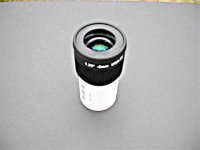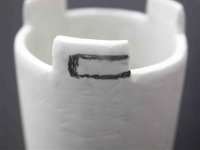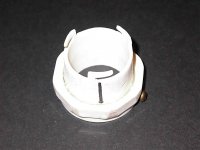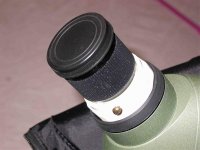Sirius Birder
Member
I have recently made a cheap but very nice astronomical eyepiece adapter for my Kowa 883. I was looking for some way to use higher powers than the 60X of the zoom eyepiece. The adapter I have made is designed around the TMB/BO Planetary eyepiece, as sold by Burgess Optical, or an equivalent Planetary sold by Teton Telescopes (available for about $60). The specific eyepiece I purchased is a 5mm focal length with 16mm eye relief and 58 degree AFOV. This eyepiece gives me about 100X with the Kowa 883. I communicated this information to Henry Link, who suggested I put the design on BirdForum.
I am including a few photos of the fabrication process for anyone who is interested in making one of these. Please examine the photos as you read. I have about 20 photos, but can only submit five. If the photos you see here are not enough for you to get the idea, let me know and I will email the others to you.
The adapter is basically two pieces of PVC with a total cost of about $1.00. The fabrication can be done in a few hours if you have the right tools. You will need a good pair of calipers for measuring diameters precisely.
The two pieces of PVC will be described below as the Inner Ring and the Outer Ring.
The Inner Ring Is a small joint of 1.25 "/32mm(inside diameter) PVC. It needed to be reamed out to 1.30"/33mm to accept the eyepiece, and cut to a length of 1.65"/42mm. The outside diameter of this Inner Ring was 1.65"/42mm. It needed to be ground down to 1.50"/38mm to fit into the scope body. The grinding down of the outside diameter is the major time consuming job, and is probably best done with a grinding wheel of some type.
Once the grinding of inside and outside is done on the Inner Ring, it will fit snugly into the scope body, and the eyepiece will fit snugly into it. Cutting the bayonet mount comes next. Mark the sections to be cut by using the little cap which comes with the scope. Depth of cut is 0.25"/6mm, and the "hook" opening of the bayonet mount is 0.14"/3.6mm. I made these cuts using a Dremel tool. These cuts allow you to push in the eyepiece holder and twist it to the right so that it locks in tight, just like a Kowa eyepiece.
The Outer Ring is a small joint of PVC which has an inside diameter of 1.65"/42mm. The Outer Ring has an octagonal end which will fit perfectly against the Kowa scope body if the points of the octagon are ground down just a little.
Only a short section of this Outer Ring is needed. Cut a piece 0.70"/18mm. This piece will include the octagonal end.
The Inner Ring and Outer Ring will need to be glued together, flush at the top. See the photos. The gap between the two rings is about 0.10"/2.5mm. A fast-setting epoxy can be used to connect these two rings, but be very careful to keep the two rings centered, and to wipe off the excess epoxy with a damp cloth before it hardens.
You will also need to drill a small hole into the side of the eyepiece adaptor to insert a set screw for holding the eyepiece securely. The set screw should be no more than 0.5"/7mm in length. It will easily make its own threads as it is screwed into the drill hole. If you want your adapter to click into locking position, you will need to cut a small notch into the under side of Outer Ring at the point where the little steel pin sticks up.
I could go into more detail, but I am afraid I would get too bogged down. Just look at the photos in sequence and you will see what is involved. Again, if you need to see more detail, send me an email.
I will note that the length of the Inner Ring is chosen specifically to allow this eyepiece to be aproximately parfocal with the 60X in the Kowa Zoom. In other words, when the zoom is removed and the 5mm with adapter inserted, very little focus wheel adjustment is needed.
John Wright.
I am including a few photos of the fabrication process for anyone who is interested in making one of these. Please examine the photos as you read. I have about 20 photos, but can only submit five. If the photos you see here are not enough for you to get the idea, let me know and I will email the others to you.
The adapter is basically two pieces of PVC with a total cost of about $1.00. The fabrication can be done in a few hours if you have the right tools. You will need a good pair of calipers for measuring diameters precisely.
The two pieces of PVC will be described below as the Inner Ring and the Outer Ring.
The Inner Ring Is a small joint of 1.25 "/32mm(inside diameter) PVC. It needed to be reamed out to 1.30"/33mm to accept the eyepiece, and cut to a length of 1.65"/42mm. The outside diameter of this Inner Ring was 1.65"/42mm. It needed to be ground down to 1.50"/38mm to fit into the scope body. The grinding down of the outside diameter is the major time consuming job, and is probably best done with a grinding wheel of some type.
Once the grinding of inside and outside is done on the Inner Ring, it will fit snugly into the scope body, and the eyepiece will fit snugly into it. Cutting the bayonet mount comes next. Mark the sections to be cut by using the little cap which comes with the scope. Depth of cut is 0.25"/6mm, and the "hook" opening of the bayonet mount is 0.14"/3.6mm. I made these cuts using a Dremel tool. These cuts allow you to push in the eyepiece holder and twist it to the right so that it locks in tight, just like a Kowa eyepiece.
The Outer Ring is a small joint of PVC which has an inside diameter of 1.65"/42mm. The Outer Ring has an octagonal end which will fit perfectly against the Kowa scope body if the points of the octagon are ground down just a little.
Only a short section of this Outer Ring is needed. Cut a piece 0.70"/18mm. This piece will include the octagonal end.
The Inner Ring and Outer Ring will need to be glued together, flush at the top. See the photos. The gap between the two rings is about 0.10"/2.5mm. A fast-setting epoxy can be used to connect these two rings, but be very careful to keep the two rings centered, and to wipe off the excess epoxy with a damp cloth before it hardens.
You will also need to drill a small hole into the side of the eyepiece adaptor to insert a set screw for holding the eyepiece securely. The set screw should be no more than 0.5"/7mm in length. It will easily make its own threads as it is screwed into the drill hole. If you want your adapter to click into locking position, you will need to cut a small notch into the under side of Outer Ring at the point where the little steel pin sticks up.
I could go into more detail, but I am afraid I would get too bogged down. Just look at the photos in sequence and you will see what is involved. Again, if you need to see more detail, send me an email.
I will note that the length of the Inner Ring is chosen specifically to allow this eyepiece to be aproximately parfocal with the 60X in the Kowa Zoom. In other words, when the zoom is removed and the 5mm with adapter inserted, very little focus wheel adjustment is needed.
John Wright.
Attachments
Last edited:








